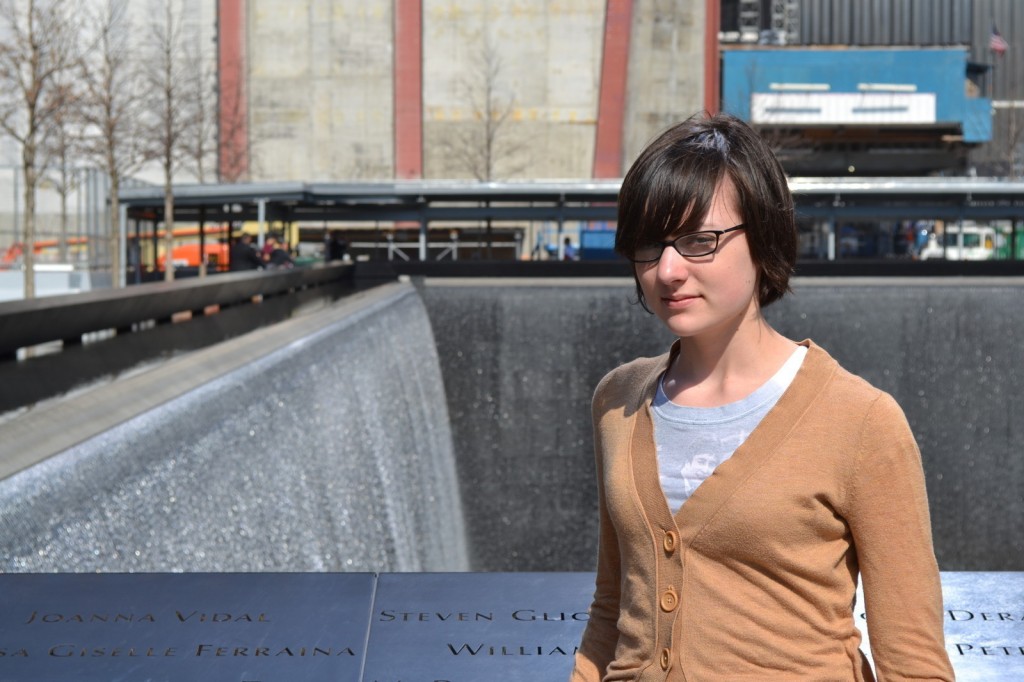
A student at the 9/11 Memorial Photo by Kenneth Senter of Oak Ridge High School
Today, September 11, is never an easy day. It is often hard to imagine that more than a decade has passed since this tragedy. Many of the students who now visit the memorial were too young to process the events of September 11, 2001. As a result, it is the challenge and responsibility of those who do remember to inform and educate this generation.
Beyond necessary classroom and home discussions, the National September 11 Memorial provides a catalyst for conversation and reflection regarding September 11, 2001 and the events that preceded and followed. A visit to the actual site solidifies your discussions with a concrete experience and memory. Your students may not bear personal memories of that day, but they will certainly remember their visit to the September 11 Memorial.
Memorial Features:
Reflecting Pools: Two nearly square acre reflecting pools sit in the footprint of the twin towers. These reflecting pools feature the largest man-made waterfalls in North America.
Bronze Panels: Bronze panels around the edge of the memorial pool are home to the the names of every person who died in the 2001 and 1993 attacks, nearly 3,000 in total. Around the North Pool are the names from World Trade Center North (1,470 names), February 26, 1993 (6 names), and Flight 11 (87 names). Around the South Pool are the names of First Responder (441 names), World Trade Center South(694 names), Flight 77 (59 names), Pentagon (129 names), and Flight 175 (60 names).
Plaza: More than 400 swamp oak trees are planned for planting in the plaza. They will provide a burst of green in the center of the metropolis in the spring, shade in the summer, and bursts of color in the fall. The plaza has a “suspended paving system,” allowing for the sustainable growth of the trees. The paving system features loose soil for healthy tree growth, while still providing a safe walkway for visitors.
Museum: Currently, the underground museum is not opened to visitors and the grand opening scheduled for September 2012 has been delayed. However, two enormous tridents are held in the large glass atrium of the museum pavilion and can be observed from the area of the memorial that is opened. These tridents are from the original façade of 1 WTC (North Tower).
Suggestions for Visiting with a Group:
- Although the memorial is free to visit, a reservation must be made for a timed ticket entry for groups of 16 or more. This is for two reasons, safety and respect. Construction is ongoing in the area. For the safety of the visitors, a tentative maximum capacity has been set. Secondly, visitor numbers are minimized to help maintain a level of peace and consideration for those reflecting on memories of loved ones.
- Arrive 15 minutes before your scheduled visit time. Late visitors cannot always be accommodated
- You do have to go through security to enter the memorial. To expedite the process, minimize the amount of baggage you are carrying with you.
- Reservations for your visit can be made up to 6 months in advance.
- Until the museum opens, there are no public restrooms at the site. Plan accordingly!
Educational Resources:
- Visiting the 9/11 Memorial: Pre-Visit Materials for the Classroom: Lesson plans aligned with common core standards produced by the National September 11 Memorial and Museum. Lesson plans cover introducing September 11 and introducing the 9/11 Memorial.
- PBS Teacher Resources on 9/11: Lesson plans produced by PBS for grades K-12 regarding peace, war, patriotism, and geography. These resources were compiled shortly after September 11, 2001, but continue to be a relevant resource for educators
- 9/11 Lesson Plans by sharemylesson: Lesson plans and powerpoint presentations developed by teachers for teachers regarding regarding discussions relevant to September 11, 2001.






















[…] Related Links: September 11 Memorial: Planning Your Visit to Ground Zero […]